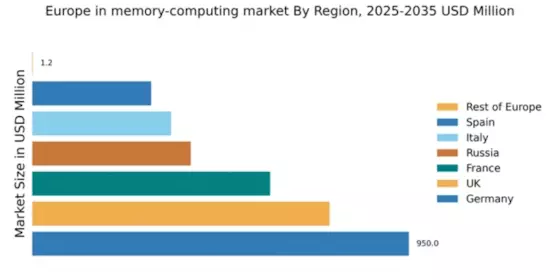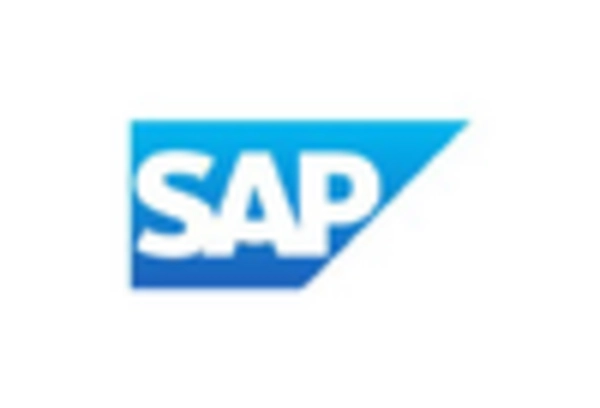Rising Data Volume
The in memory-computing market in Europe is experiencing a surge in demand due to the exponential growth of data generated by businesses. As organizations increasingly rely on data-driven decision-making, the need for rapid data processing capabilities becomes paramount. In 2025, it is estimated that the total data generated in Europe will reach approximately 100 zettabytes, necessitating advanced computing solutions. In memory-computing technologies enable real-time data processing, allowing businesses to derive insights quickly and efficiently. This trend is particularly evident in sectors such as finance and retail, where timely data analysis can lead to competitive advantages. Consequently, the rising data volume is a significant driver for the in memory-computing market, as companies seek to enhance their operational efficiency and responsiveness to market changes.
Advancements in Technology
Technological advancements play a crucial role in shaping the in memory-computing market in Europe. Innovations in hardware and software are enabling more efficient data processing capabilities, which are essential for handling large datasets. The introduction of faster processors and improved memory architectures is allowing organizations to deploy in memory-computing solutions that can process data at unprecedented speeds. In 2025, the market for in memory-computing solutions in Europe is expected to grow by approximately 25%, driven by these technological enhancements. Furthermore, the integration of in memory-computing with cloud technologies is facilitating scalability and flexibility, making it an attractive option for businesses looking to optimize their operations. As a result, advancements in technology are a key driver for the in memory-computing market.
Growing Adoption of IoT Devices
The proliferation of Internet of Things (IoT) devices is emerging as a pivotal driver for the in memory-computing market in Europe. As more devices become interconnected, the volume of data generated is increasing exponentially, necessitating advanced computing solutions for real-time data processing. In 2025, it is projected that the number of IoT devices in Europe will surpass 30 billion, creating a substantial demand for in memory-computing technologies. These solutions enable organizations to analyze data from IoT devices instantaneously, facilitating timely decision-making and operational efficiency. Industries such as manufacturing and healthcare are particularly benefiting from this trend, as they leverage in memory-computing to optimize processes and enhance service delivery. Thus, the growing adoption of IoT devices is likely to significantly impact the in memory-computing market.
Regulatory Compliance Requirements
The in memory-computing market in Europe is also being shaped by stringent regulatory compliance requirements. Organizations are increasingly required to adhere to data protection regulations, such as the General Data Protection Regulation (GDPR), which mandates the secure handling of personal data. In response, businesses are turning to in memory-computing solutions to ensure compliance while maintaining operational efficiency. These technologies allow for the rapid processing of data in a secure environment, enabling organizations to meet regulatory demands without sacrificing performance. As compliance becomes a critical concern for businesses across various sectors, the demand for in memory-computing solutions is likely to rise, positioning regulatory compliance as a significant driver in the market.
Increased Focus on Customer Experience
In the current landscape, the in memory-computing market in Europe is significantly influenced by the heightened emphasis on customer experience. Organizations are increasingly leveraging in memory-computing solutions to provide personalized services and improve customer interactions. By utilizing real-time data analytics, businesses can tailor their offerings to meet individual customer preferences, thereby enhancing satisfaction and loyalty. For instance, companies in the e-commerce sector are employing in memory-computing technologies to analyze customer behavior and optimize their marketing strategies. This shift towards customer-centric approaches is projected to drive the in memory-computing market, as firms invest in technologies that facilitate immediate insights and responsive service delivery.


















Leave a Comment